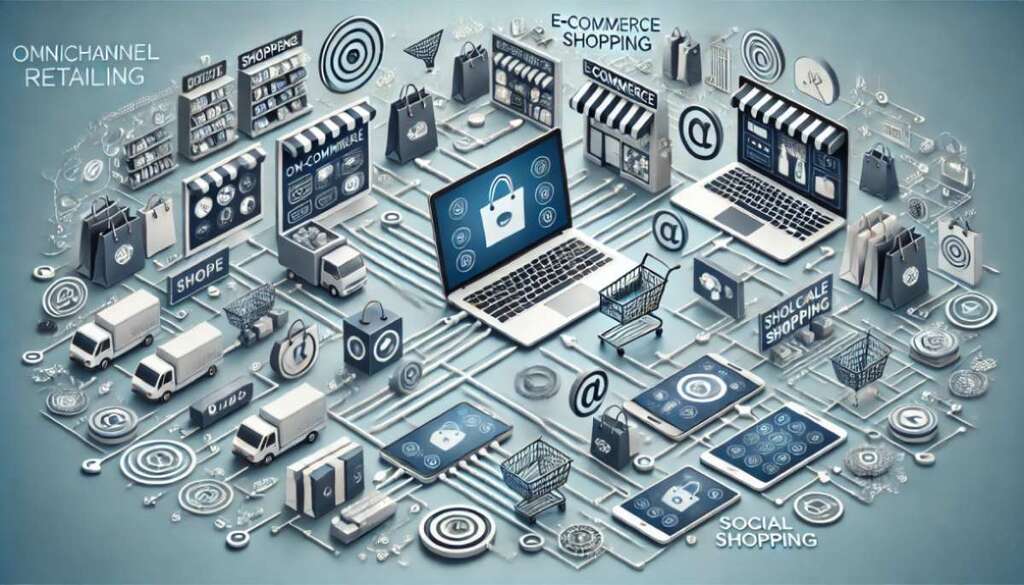In today’s fast-paced, digitally driven world, the lines between online and offline shopping are increasingly blurred. Consumers no longer see a distinction between the two—they expect a seamless experience that transcends the physical and digital realms. This shift has given rise to the concept of omnichannel retailing, a strategy that unifies all customer touchpoints into one cohesive experience. But what exactly is omnichannel retailing, and why is it so crucial for modern businesses?
What is Omnichannel Retailing?
Omnichannel retailing is the integration and cooperation of various shopping channels, such as physical stores, e-commerce websites, mobile apps, social media, and even phone support. The goal is to provide customers with a consistent and seamless shopping experience, regardless of the channel they choose to engage with.

For example, a customer might browse products on a retailer’s website, check reviews on social media, visit a physical store to see the product in person, and then complete the purchase on their mobile app. In an omnichannel approach, each of these steps is interconnected, allowing the customer to pick up exactly where they left off, regardless of the platform.
The Rise of Omnichannel Retailing
The rise of omnichannel retailing can be attributed to changing consumer behaviors and technological advancements. Today’s consumers are more empowered than ever, with a wealth of information at their fingertips. They want the flexibility to shop on their terms, whether that’s online, in-store, or a mix of both.
Moreover, the COVID-19 pandemic accelerated the adoption of digital channels, forcing businesses to rethink their strategies. As a result, the boundaries between online and offline shopping have become increasingly fluid, making omnichannel retailing not just an option, but a necessity for retailers aiming to stay competitive.
Benefits of Omnichannel Retailing
- Enhanced Customer Experience: The primary advantage of omnichannel retailing is the ability to provide a seamless and personalized customer experience. By connecting all channels, retailers can offer tailored recommendations, consistent messaging, and easy transitions between different platforms.
- Increased Sales and Customer Loyalty: When customers have a positive shopping experience, they are more likely to make a purchase and return in the future. Omnichannel strategies often lead to higher customer retention rates and increased sales by offering multiple avenues for customers to interact with the brand.
- Better Data and Insights: Omnichannel retailing allows businesses to collect and analyze data from various channels, providing valuable insights into customer behavior and preferences. This data can be used to refine marketing strategies, optimize inventory management, and improve overall operations.
- Competitive Advantage: In a crowded market, offering an omnichannel experience can set a brand apart from its competitors. Businesses that successfully implement this strategy can build stronger relationships with customers, driving long-term success.
Key Elements of a Successful Omnichannel Strategy
- Unified Commerce Platform: To achieve true omnichannel retailing, businesses need a unified commerce platform that integrates all sales channels. This ensures that inventory, customer data, and transactions are synchronized across the board.
- Consistent Branding and Messaging: Whether a customer is browsing your website, scrolling through your social media, or visiting your store, they should encounter consistent branding and messaging. This helps reinforce brand identity and build trust with customers.
- Personalization: Personalization is key to enhancing the customer experience. By leveraging data from various channels, retailers can offer personalized recommendations, targeted promotions, and tailored content that resonates with individual customers.
- Seamless Integration of Online and Offline Channels: For an omnichannel strategy to be effective, there must be seamless integration between online and offline channels. This includes offering options like buy online, pick up in-store (BOPIS), or allowing returns and exchanges across different channels.
- Customer-Centric Approach: Finally, an omnichannel strategy should always prioritize the customer. Understanding their needs, preferences, and pain points is essential for creating a shopping experience that exceeds expectations.
Challenges in Implementing Omnichannel Retailing
While the benefits of omnichannel retailing are clear, implementing this strategy is not without its challenges. Integrating different channels requires significant investment in technology and infrastructure. Retailers must also overcome logistical hurdles, such as ensuring real-time inventory visibility and managing complex supply chains.
Additionally, maintaining a consistent customer experience across all touchpoints can be difficult, especially for large organizations with multiple departments and locations. However, these challenges can be mitigated with careful planning, the right technology, and a customer-centric mindset.
The Future of Omnichannel Retailing
As technology continues to evolve, so too will the possibilities for omnichannel retailing. We can expect to see even greater integration between physical and digital channels, with innovations such as augmented reality (AR) shopping experiences, AI-driven personalization, and more advanced mobile payment solutions.
In the future, the most successful retailers will be those who can anticipate and adapt to changing consumer behaviors, leveraging omnichannel strategies to create a truly unified and engaging shopping experience.
Conclusion
Omnichannel retailing is no longer just a buzzword—it’s the future of retail. By integrating online and offline channels, businesses can offer a seamless and personalized shopping experience that meets the needs of today’s empowered consumers. As the retail landscape continues to evolve, those who embrace omnichannel retailing will be well-positioned to thrive in an increasingly competitive market.






